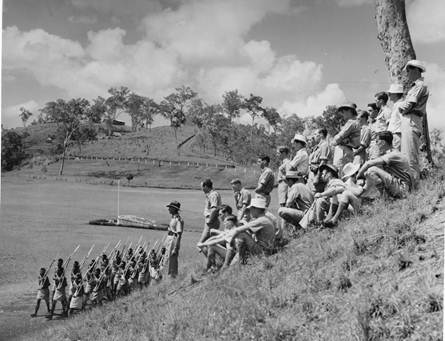
PNGAA Library
A career with a challenge: Australian patrol officers in PNG: Tracey Clarke

Before Papua New Guinea achieved independence from Australia in 1975, a number of young Australian men served as patrol officers there. Records in the National Archives help tell the story of the kiaps and the role they played.

A group of cadet patrol officers are shown the Royal Papuan Constabulary police barracks at Sogeri, in the hills behind Port Moresby, 1950. NAA: A6510, 1477
More than 2000 Australians served as patrol and district officers in the former Territory of Papua and New Guinea between 1949 and 1974. They were commonly known as ‘kiaps’, a pidgin version of the German kapitän (captain).
Following World War II, the Australian Government encouraged young men aged between 18 and 24 with "initiative, imagination and courage" to apply to become cadet patrol officers in Papua and New Guinea. Young women were also invited to apply for positions, such as cadet education officers, but they were ineligible for patrol work.
The government received hundreds of applications each year from young men eager for a new challenge. Many had already read books about the experiences of the patrol officer; Leslie Rees' novel, Danger Patrol: A Young Patrol Officer's Adventures in New Guinea, was compulsory reading for school children in several Australian states. A number of applicants were ex-servicemen and had acquired knowledge of the area during the war. Some men had joined for altruistic reasons.
Each applicant had to submit satisfactory evidence of good character, health and physical fitness for employment in a tropical climate. Successful applicants were required to complete a short training course at the Australian School of Pacific Administration (ASOPA) before they were sent to Papua New Guinea for field experience under the supervision of veteran kiaps. After a term of 21 months a cadet became a patrol officer.
The responsibilities of patrol officers were broad and varied: they maintained law and order as commissioned officers in the Field Division of the Royal Papua & New Guinea Constabulary and as magistrates of local courts. They introduced basic services such as postal and radio communication, roads and airstrips; and they patrolled villages and maintained contact with village leaders. Their role was to bring the benefits of "modern civilisation" and a form of governance to villages scattered throughout numerous administrative districts.
Kiaps wrote detailed reports about their patrols, which give their impressions of European contact with remote villages, health care, the administration of justice, languages and tribal warfare. Kiaps also made general observations on demographic trends, land disputes, initiation ceremonies and instances of cannibalism, as well as such matters as housing, cooking methods and vegetable gardens.
The National Archives holds numerous records about kiaps, including personnel and correspondence files, photographs, maps and patrol reports. Many are on microfiche. These records are an important source of information on the pre-independence history of Papua New Guinea. They also reveal the varied experiences of Australian kiaps, and the challenges they faced in this unfamiliar and sometimes difficult environment.
Many Australian men who responded to the government's call would agree with the sentiments expressed by former kiap James Patrick (Jim) Sinclair: "the years so spent are in many ways the finest and most rewarding of the patrol officer’s life, filled with the satisfaction of country covered, new people seen and new mountains climbed."
Tracey Clarke is a curator at the National Archives. This article was first published in Memento, issue 39, and is reprinted with permission from the National Archives of Australia: www.naa.gov.au.